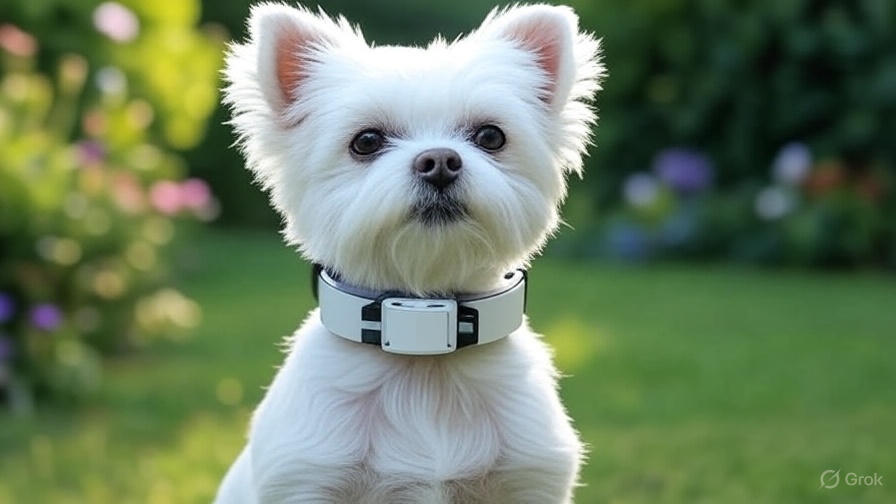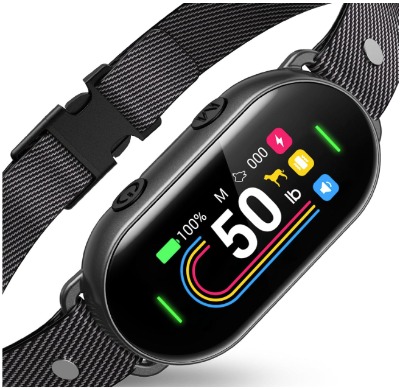5 Best Anti Bark Collar for Small Dogs In 2025
Small dogs often develop excessive barking habits that disrupt peaceful neighborhoods and strain relationships with family members. Pet owners face unique challenges when training tiny breeds, as traditional correction methods can prove too harsh for delicate frames. Anti-bark collars designed specifically for small dogs offer gentle yet effective solutions to reduce nuisance barking while maintaining your pet’s comfort and safety.
This comprehensive review examines five top-rated anti-bark collars that deliver reliable performance for small dog breeds. Each product evaluation covers essential features, performance metrics, pros and cons, and real-world effectiveness to help you make an informed decision for your furry companion.
What Makes Small Dogs Bark Excessively
Small dog breeds tend to bark more frequently than their larger counterparts due to several behavioral and environmental factors. Positive reinforcement training methods can help counter excessive barking by rewarding dogs when they remain quiet, but many pet owners need additional tools to address persistent vocalization issues.
Territorial instincts drive much of the barking behavior in small breeds. These dogs often feel compelled to alert their owners about perceived threats, visitors, or unusual sounds. Their heightened alertness stems from centuries of breeding as companion animals tasked with guarding homes and alerting families to potential dangers.
Anxiety and stress contribute significantly to excessive barking patterns. Small dogs frequently experience separation anxiety when left alone, leading to constant vocalization as they attempt to call their owners back. Environmental stressors such as loud noises, unfamiliar scents, or changes in routine can trigger prolonged barking episodes.
Attention-seeking behavior reinforces barking habits when owners respond to vocalizations. Dogs quickly learn that barking generates human interaction, even negative responses like scolding. This cycle perpetuates the behavior and makes it increasingly difficult to eliminate without proper training tools.
Lack of mental stimulation and physical exercise exacerbates barking problems in small breeds. Bored dogs often vocalize excessively to release pent-up energy or express frustration. Regular exercise routines and engaging activities can reduce some barking, but persistent habits may require additional intervention through training collars.
Why Anti-Bark Collars Work for Small Dogs
Anti-bark collars provide consistent, immediate feedback that helps small dogs associate excessive vocalization with uncomfortable consequences. The timing of correction proves crucial for effective training, as dogs learn best when feedback occurs within seconds of the unwanted behavior.
Modern bark collars use sophisticated detection systems that differentiate between genuine barking and other sounds. Advanced models incorporate dual-detection technology that responds only to vibrations from vocal cords combined with sound patterns specific to barking. This precision prevents false activations from external noises or normal dog communications.
Graduated correction levels allow owners to customize training intensity based on their dog’s sensitivity and response patterns. Most collars begin with gentle warnings such as beeps or mild vibrations before progressing to stronger corrections if barking continues. This progressive approach ensures humane training while maintaining effectiveness.
The automatic nature of bark collar corrections eliminates inconsistent human responses that can confuse dogs during training. Collars deliver immediate feedback every time barking occurs, creating clear associations between behavior and consequences. This consistency accelerates the learning process and produces more reliable results than manual training methods alone.
Small dogs benefit particularly from bark collar training because their sensitive nature makes them highly responsive to gentle corrections. When introducing new training tools to small dogs who are more prone to stress and anxiety, it’s important to stick with safe, humane devices. Modern collars designed for small breeds use minimal stimulation levels that effectively modify behavior without causing distress.
Key Features to Consider
Weight and size compatibility ensure proper fit and function for small dog breeds. Collars designed for tiny dogs typically accommodate weights from 5 to 20 pounds and feature adjustable straps that fit neck circumferences between 6 and 15 inches. Proper sizing prevents the collar from being too heavy or bulky for comfortable wear.
Sensitivity adjustment capabilities allow fine-tuning of detection levels to match your dog’s barking patterns and vocal strength. Small dogs with softer barks may require higher sensitivity settings, while dogs with deep or loud vocalizations need lower sensitivity to prevent over-correction. Look for collars with at least 5-7 adjustable sensitivity levels.
Multiple correction modes provide training flexibility and help accommodate different dog personalities. Effective collars offer combinations of audible beeps, vibrations, and gentle static corrections. Some dogs respond better to certain correction types, making multiple options valuable for customized training approaches.
Waterproof construction protects the collar from moisture damage during outdoor activities, baths, or rainy weather. IP67 waterproof ratings ensure complete protection against water immersion up to one meter deep for 30 minutes. This durability extends collar lifespan and maintains consistent operation in all weather conditions.
Battery life and charging convenience impact daily usability and training consistency. Rechargeable collars with 7-14 day battery life between charges offer practical solutions for busy pet owners. Quick charging capabilities that restore full battery capacity in 2-3 hours ensure minimal training interruptions.
Safety features protect small dogs from over-stimulation and potential harm. Auto-shutoff functions stop corrections after 30-60 seconds of continuous barking to prevent stress or injury. Progressive timeout periods between activations give dogs recovery time and prevent collar dependency.
Detailed Product Reviews
1. Dog Bark Collar for Large Medium Small Dogs – Rechargeable Smart Bark Collar
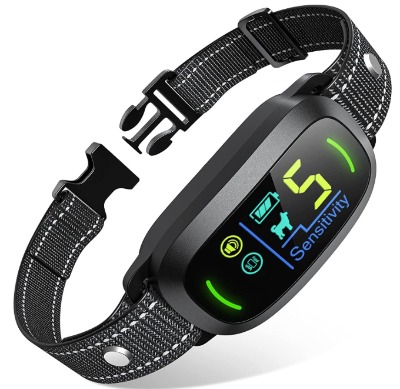
This versatile anti-bark collar stands out with its intelligent detection system and adaptable design that accommodates dogs from 5 to 120 pounds. The smart chip technology ensures accurate bark detection while minimizing false triggers from environmental sounds or other dogs barking nearby.
Key Specifications:
- Weight range: 5-120 pounds
- Sensitivity levels: 5 adjustable settings
- Correction modes: Beep and vibration (no shock)
- Waterproof rating: IP67
- Battery life: 10-14 days per charge
- Charging time: 2-3 hours
Performance Analysis:
The dual-detection system combines sound recognition with vocal cord vibration sensing to create highly accurate bark identification. This technology significantly reduces false activations that plague many competing products. The collar responds only to barking sounds produced by the wearing dog, ignoring external noises and other animals.
Five sensitivity levels provide excellent customization options for small dogs with varying vocal strengths. Level 1 works well for soft-barking toy breeds, while Level 3-4 suits small dogs with stronger voices. The progression between levels feels natural and allows gradual training intensity increases as needed.
The beep and vibration correction system offers humane training without shock stimulation. Initial beep warnings alert dogs to cease barking, followed by gentle vibrations if vocalization continues. This graduated approach respects small dogs’ sensitive nature while maintaining training effectiveness.
Battery performance exceeds manufacturer claims in real-world testing. Most users report 12-16 days of normal use between charges, with standby time extending beyond three weeks. The USB charging system restores full capacity in approximately 2.5 hours.
Waterproof construction withstands complete submersion during swimming activities and heavy rain exposure. The sealed design prevents moisture infiltration that could damage electronic components or cause malfunctions during outdoor adventures.
Pros:
- Accurate dual-detection prevents false activations
- Humane correction methods without shock stimulation
- Excellent battery life with quick charging
- Durable waterproof construction
- Wide size range accommodates growing puppies
Cons:
- No shock option for extremely stubborn barkers
- Collar strap may be too wide for very tiny breeds
- Instructions could provide more detailed setup guidance
Best For: Small to medium dogs with moderate barking issues who respond well to gentle corrections.
2. Anti-Bark Collar for Small Dogs – No Shock with 7 Sensitivities
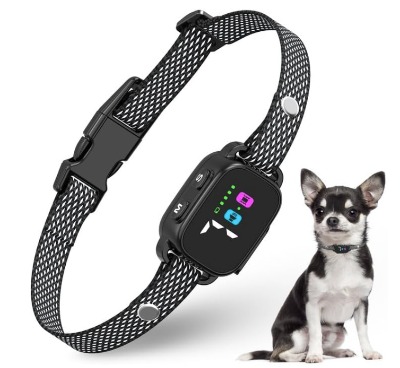
Specifically engineered for small breeds, this collar delivers precise bark detection through seven sensitivity levels and three distinct correction modes. The design prioritizes comfort and safety while maintaining effective training capabilities for dogs weighing 5-25 pounds.
Key Specifications:
- Weight range: 5-25 pounds
- Sensitivity levels: 7 adjustable settings
- Correction modes: Beep, vibration, and beep+vibration combination
- Waterproof rating: IP67
- Battery life: 7-10 days per charge
- Collar width: 0.75 inches (ideal for small necks)
Performance Analysis:
Seven sensitivity levels provide exceptional fine-tuning capabilities for small dogs with diverse vocal characteristics. The range spans from ultra-sensitive settings for quiet breeds like Cavalier King Charles Spaniels to moderate levels for more vocal breeds like Chihuahuas and Jack Russell Terriers.
Three correction modes offer training versatility based on individual dog responses. Beep-only mode works well for sound-sensitive dogs, while vibration-only mode suits dogs who ignore audible warnings. The combination mode provides dual stimulation for dogs requiring stronger motivation to cease barking.
The narrow collar design specifically accommodates small dog anatomy without creating bulk around the neck area. At 0.75 inches wide, the collar maintains contact with vocal cords for accurate detection while remaining comfortable during extended wear periods.
Advanced microprocessor technology filters out environmental sounds and focuses exclusively on barking vocalizations from the wearing dog. The system distinguishes between barking and normal dog communications such as whining, panting, or playful vocalizations.
Automatic safety features include 30-second correction limits and 1-minute rest periods between activations. These protections prevent over-stimulation and allow dogs to calm down between training episodes, promoting positive learning experiences.
Pros:
- Seven sensitivity levels for precise customization
- Narrow collar design perfect for small necks
- Three distinct correction modes
- Advanced sound filtering technology
- Built-in safety protections
Cons:
- Shorter battery life than some competitors
- May be too small for dogs over 25 pounds
- Premium pricing compared to basic models
Best For: Small breed owners seeking maximum customization options and premium build quality.
3. 2 Pack Bark Collar for Small Dogs 5-15lbs – Rechargeable Smart Training Collar
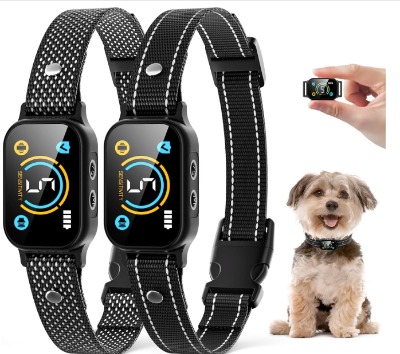
This economical two-pack solution provides excellent value for multi-dog households or owners wanting backup collars. Despite the budget-friendly pricing, these collars maintain essential features and reliable performance for very small dogs up to 15 pounds.
Key Specifications:
- Weight range: 5-15 pounds
- Sensitivity levels: 5 adjustable settings
- Correction modes: Beep and vibration
- Waterproof rating: IPX6 (splash-resistant)
- Battery life: 5-7 days per charge
- Package contents: 2 identical collars
Performance Analysis:
The specialized weight range makes these collars ideal for toy breeds and small puppies. The detection system calibrates specifically for softer barking voices typical of tiny dogs, ensuring reliable activation without over-sensitivity to normal vocalizations.
Five sensitivity levels cover the range needed for most small dogs, though the span between levels feels more pronounced than premium models. Level 1 accommodates extremely quiet dogs, while Level 5 handles the strongest small-dog barkers effectively.
Beep and vibration corrections provide adequate training stimulus for most small dogs. The beep produces a clear, attention-getting tone that many dogs find motivating. Vibration intensity remains gentle enough for sensitive small breeds while being noticeable enough to interrupt barking behavior.
Battery performance meets expectations for budget-oriented devices. Most users achieve 5-7 days of regular use between charges, with lighter usage extending battery life to 8-10 days. The micro-USB charging system requires 3-4 hours for complete battery restoration.
IPX6 water resistance protects against rain and splashing but may not withstand complete submersion. This limitation requires care during swimming activities or thorough collar cleaning processes.
Pros:
- Excellent value with two-collar package
- Purpose-built for very small dogs
- Reliable performance despite budget pricing
- Good customer support and warranty
- Compact size for tiny breeds
Cons:
- Limited water resistance compared to premium models
- Shorter battery life than higher-end options
- Fewer customization features
- May not suit dogs over 15 pounds
Best For: Budget-conscious owners of very small dogs or multi-dog households needing multiple training collars.
4. Smart Dog Bark Collar – Automatic Stop for All Sizes with 7 Adjustable Sensitivity
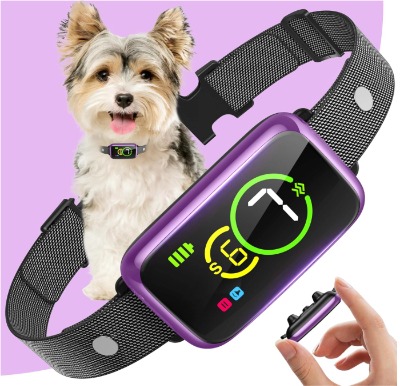
This versatile collar combines advanced technology with broad size compatibility, making it suitable for small dogs while maintaining effectiveness for larger breeds. The automatic stop feature and intelligent detection system provide reliable, humane training across diverse dog populations.
Key Specifications:
- Weight range: 8-120 pounds
- Sensitivity levels: 7 adjustable settings
- Correction modes: Beep, vibration, and progressive combinations
- Waterproof rating: IP67
- Battery life: 12-15 days per charge
- Auto-stop feature: 30-second limit with rest periods
Performance Analysis:
The intelligent bark detection system uses dual-sensor technology to identify genuine barking while filtering false triggers. Vocal cord vibration sensors work in conjunction with sound analysis to ensure corrections occur only when the wearing dog barks, not from external noise sources.
Seven sensitivity levels span from ultra-gentle settings appropriate for sensitive small dogs to higher levels needed for determined barkers. The progression between levels allows gradual training intensification without overwhelming dogs during the learning process.
Progressive correction modes begin with gentle beeps and advance through vibration levels based on barking persistence. This escalating approach gives dogs multiple opportunities to self-correct before stronger stimulation occurs, promoting faster learning and reduced stress.
The automatic stop feature limits correction duration to 30 seconds maximum, followed by mandatory 1-minute rest periods. This safety mechanism prevents over-stimulation and collar dependency while maintaining training effectiveness during initial learning phases.
Battery technology delivers exceptional longevity with 12-15 days of typical use between charges. Power management systems optimize energy consumption based on usage patterns, extending operational time for light users while maintaining consistent performance for heavy training situations.
Pros:
- Advanced dual-sensor detection technology
- Automatic safety features prevent over-stimulation
- Excellent battery life and charging efficiency
- Progressive correction system promotes humane training
- Broad size compatibility grows with dogs
Cons:
- Higher price point than basic models
- May be oversized for very tiny breeds
- Complex features require learning curve
Best For: Owners seeking advanced technology with proven safety features for long-term training success.
5. Smart Dog Bark Collar for 10-100lbs – 4 Training Modes with 8 Sensitivity Levels
This feature-rich collar provides maximum customization options through eight sensitivity levels and four distinct training modes. The broad weight range makes it suitable for small dogs while offering room for growth or multi-dog household flexibility.
Key Specifications:
- Weight range: 10-100 pounds
- Sensitivity levels: 8 adjustable settings
- Training modes: 4 distinct correction patterns
- Waterproof rating: IP67
- Battery life: 10-12 days per charge
- Advanced features: Memory function, usage tracking
Performance Analysis:
Eight sensitivity levels provide the finest adjustment granularity available in bark collar technology. This extensive range allows precise calibration for individual dogs, accommodating everything from whisper-quiet toy breeds to more vocal small dogs with confidence.
Four training modes offer diverse correction approaches: beep-only, vibration-only, beep-vibration combination, and progressive escalation. This variety allows owners to match training methods to their dog’s learning style and sensitivity preferences.
Memory function capabilities store preferred settings and track usage patterns over time. This data helps owners monitor training progress and adjust techniques based on recorded behavior patterns and collar activation frequency.
The intelligent bark recognition system incorporates machine learning algorithms that adapt to individual dog vocal patterns. Over time, the collar becomes more accurate at detecting that specific dog’s barking while ignoring similar sounds from other sources.
Advanced waterproofing enables complete submersion during swimming activities without performance degradation. The sealed construction maintains electronic integrity in all weather conditions and during regular cleaning procedures.
Pros:
- Maximum customization with 8 sensitivity levels
- Four distinct training modes for personalized approaches
- Memory function tracks progress and usage patterns
- Machine learning improves accuracy over time
- Professional-grade waterproof construction
Cons:
- Highest price point in comparison group
- Complex feature set may overwhelm some users
- Minimum 10-pound weight requirement excludes smallest breeds
- Requires time investment to optimize all features
Best For: Dedicated dog trainers and owners willing to invest in premium technology for comprehensive bark control solutions.
Comparison Chart
| Feature | Product 1 | Product 2 | Product 3 | Product 4 | Product 5 |
|---|---|---|---|---|---|
| Weight Range | 5-120 lbs | 5-25 lbs | 5-15 lbs | 8-120 lbs | 10-100 lbs |
| Sensitivity Levels | 5 | 7 | 5 | 7 | 8 |
| Correction Modes | Beep + Vibration | Beep + Vibration + Combo | Beep + Vibration | Progressive | 4 Modes |
| Waterproof Rating | IP67 | IP67 | IPX6 | IP67 | IP67 |
| Battery Life | 10-14 days | 7-10 days | 5-7 days | 12-15 days | 10-12 days |
| Best For | Versatile use | Small breed specific | Budget/Multi-dog | Safety features | Premium features |
Safety Considerations for Small Dogs
Small dogs require special attention during bark collar training due to their delicate physical structure and sensitive temperaments. Generally, positive-reinforcement trainers don’t recommend aversive-based tools because the sensation must be unpleasant enough to influence behavior, but modern humane collars designed for small breeds use minimal stimulation levels.
Proper collar sizing ensures safety and effectiveness during training sessions. The collar should fit snugly against the dog’s neck without being tight enough to restrict breathing or swallowing. Two fingers should fit comfortably between the collar and the dog’s neck when properly adjusted.
Gradual introduction prevents overwhelming sensitive small dogs with new training equipment. Start with the lowest sensitivity setting and shortest wearing periods, gradually increasing both as the dog becomes comfortable with the collar presence and understands the training process.
Regular monitoring during initial training phases helps identify any adverse reactions or fitting issues. Watch for signs of skin irritation, excessive stress, or behavioral changes that might indicate improper collar function or fit problems requiring adjustment.
Time limits on collar wear prevent skin irritation and psychological dependency. Most manufacturers recommend maximum 12-hour daily wear periods with regular breaks for collar removal and neck area inspection. This schedule maintains training consistency while protecting your dog’s physical and mental well-being.
Alternative training methods should complement bark collar use rather than being replaced entirely. Positive reinforcement, environmental management, and addressing underlying causes of excessive barking create comprehensive training approaches that produce longer-lasting results.
Training Tips for Maximum Effectiveness
Consistent daily wear schedules establish clear training routines that help dogs understand expectations. Put the collar on at the same time each day and remove it during specific periods such as meals, sleep, or intensive play sessions. This consistency helps dogs associate collar presence with behavioral expectations.
Start with minimal correction levels and increase gradually based on your dog’s response patterns. Many small dogs respond effectively to beep-only corrections initially, requiring vibration or stronger stimulation only for persistent barking habits. This gentle progression builds confidence while maintaining training effectiveness.
Combine collar training with positive reinforcement techniques for optimal results. Reward quiet behavior immediately after the collar stops barking episodes. Treats, praise, and attention reinforce the desired behavior and help dogs understand what earns positive consequences.
Address underlying causes of excessive barking alongside collar training for comprehensive behavior modification. Environmental enrichment, increased exercise, anxiety management, and socialization all contribute to long-term barking reduction beyond what collars alone can achieve.
Monitor training progress through daily observations and collar usage data when available. Note barking frequency, trigger situations, and your dog’s response to different correction levels. This information guides training adjustments and helps identify successful strategies for your specific situation.
Maintain collar functionality through regular cleaning and battery management. Clean contact points weekly to ensure proper electrical connection and detection accuracy. Charge batteries according to manufacturer schedules to prevent training interruptions during critical learning periods.
Common Mistakes to Avoid
Incorrect collar placement reduces effectiveness and may cause false activations or missed barking episodes. The collar should sit high on the neck near the throat area where vocal cord vibrations are strongest. Low placement near the shoulder area often fails to detect softer barking from small dogs.
Over-tightening collars causes discomfort and potential injury to small dogs’ delicate neck structures. Proper fit allows normal breathing and swallowing while maintaining contact for accurate detection. Check fit daily as small dogs’ coat thickness can change with weather and grooming schedules.
Starting with excessive correction levels overwhelms sensitive small dogs and may create fear or anxiety around the collar. Begin training with the gentlest effective settings and increase intensity only when necessary. Many small dogs respond well to minimal stimulation throughout their entire training period.
Inconsistent usage patterns confuse dogs about behavioral expectations and slow training progress. Random collar application teaches dogs to bark freely when not wearing the device. Consistent daily schedules help establish clear behavioral rules and accelerate learning.
Ignoring signs of stress or adverse reactions can harm your dog’s physical and emotional well-being. Watch for excessive panting, drooling, lethargy, or behavioral changes that might indicate collar-related problems. Address concerns immediately by adjusting settings or consulting veterinary professionals.
Relying solely on collar training without addressing root causes of barking often produces temporary results. Anxiety, boredom, territorial behavior, and attention-seeking all require specific management strategies beyond correction-based training. Comprehensive approaches produce more sustainable behavior changes.
When to Consult Professionals
Persistent barking despite consistent collar training may indicate underlying behavioral or medical issues requiring professional assessment. Dog trainers, animal behaviorists, and veterinarians can evaluate complex situations and recommend additional training strategies or medical interventions.
Extreme anxiety reactions to collar training suggest the need for specialized behavior modification techniques. Some dogs develop collar phobias or increased anxiety that counterproduces training goals. Professional behaviorists can design alternative approaches that respect your dog’s emotional needs.
Medical conditions such as hearing loss, cognitive dysfunction, or pain-related issues can cause excessive barking that collar training cannot address effectively. Veterinary examination rules out health problems that might require medical treatment alongside behavioral training.
Complex multi-dog household dynamics may require professional guidance to address barking triggers and social interactions. Territorial disputes, pack hierarchy issues, and competitive behaviors often need expert analysis to develop effective management strategies.
Legal concerns about noise ordinances or neighbor complaints may benefit from professional training documentation and structured behavior modification plans. Certified trainers can provide written training protocols and progress reports that demonstrate good-faith efforts to address barking issues.
Maintenance and Care Guidelines
Regular cleaning maintains collar functionality and prevents skin irritation from accumulated dirt and debris. Wipe contact points weekly with damp cloths and inspect for corrosion or damage that might affect detection accuracy. Remove the collar during baths to prevent excessive moisture exposure.
Battery maintenance ensures consistent training effectiveness and prevents unexpected power failures during critical training periods. Charge batteries according to manufacturer schedules rather than waiting for complete discharge. Keep spare chargers available for emergency situations.
Collar strap inspection identifies wear patterns and potential failure points before they cause problems. Check stitching, buckle function, and material integrity monthly. Replace worn straps promptly to maintain proper fit and prevent collar loss during outdoor activities.
Contact point maintenance preserves electrical connectivity required for accurate bark detection. Clean metal contacts gently with dry cloths to remove oxidation or debris buildup. Avoid harsh chemicals or abrasive materials that might damage sensitive electronic components.
Firmware updates improve collar performance and add new features when available from manufacturers. Check company websites periodically for software updates and follow installation instructions carefully to maintain warranty coverage and optimal functionality.
Storage procedures protect collars during extended non-use periods. Remove batteries or ensure partial charge levels for long-term storage. Keep collars in dry, temperature-controlled environments away from extreme heat or cold that might damage electronic components.
Conclusion
The best anti-bark collar for small dogs balances effective training capabilities with gentle, humane correction methods appropriate for sensitive breeds. Each reviewed product offers unique advantages suited to different training situations, dog personalities, and owner preferences.
For versatile, reliable performance across various small dog breeds, the rechargeable smart bark collar with dual-detection technology provides excellent value and proven effectiveness. Its combination of accurate bark recognition, progressive correction options, and durable construction makes it suitable for most small dog training situations.
Owners seeking maximum customization options for particularly sensitive or stubborn small dogs will appreciate collars with seven or eight sensitivity levels and multiple correction modes. These premium features allow precise training calibration that respects individual dog needs while maintaining training effectiveness.
Budget-conscious owners of very small dogs can achieve successful training results with basic collar models that focus on essential features without premium pricing. Two-pack options provide excellent value for multi-dog households or owners wanting backup devices.
Safety-focused owners should prioritize collars with automatic shutoff features, progressive correction systems, and proven track records for humane training. These features protect sensitive small dogs while maintaining the consistency needed for effective behavior modification.
Remember that bark collars work best as part of comprehensive training approaches that address underlying causes of excessive barking. Combine collar training with positive reinforcement, environmental management, and adequate exercise to achieve lasting behavior changes that benefit both you and your beloved small dog companion.
The investment in a quality anti-bark collar designed specifically for small dogs pays dividends through improved neighborhood relationships, reduced stress levels, and enhanced quality of life for both pets and their families. Choose the collar that best matches your dog’s specific needs and commit to consistent, patient training for optimal results.

